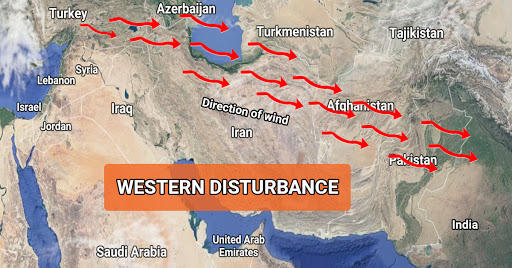What are Western Disturbances?
The recent Western Disturbance is responsible for an increased amount of snowfall in J&K, Himachal Pradesh and Uttarakhand and the rapid dip in Delhi’s temperature. In several other states, the Western Disturbances have tightened its grip creating foggy conditions.
What are Western Disturbances?
- It travels from the western to the Eastern part of the world. Disturbance means an area with reduced (disturbed) air pressure.
- Western Disturbances are extra- tropical storms that originates in the Mediterranean region. The winds travel at a speed of 43 km/hour. These Western Disturbances keep travelling until they are inhibited by the Himalayas.
- The Western Disturbances are driven by the Westerlies (prevailing winds that blow from the west to east).
- The Western Disturbance is an area of low pressure that is responsible for bringing in sudden rains, snowfall and fogs in north-western India.
- On an average, four to five western disturbances occur every winter. The weather conditions created by one western disturbance, say foggy atmosphere or rainfall, prevails till the next western disturbance approaches.
Significance of Western Disturbances
These Western Disturbances bring moderate to heavy rains in the north western India. The rains are important for rabi crops that help to meet food security of the country. The amount of rainfall and their distribution varies with every western disturbance.
The Western Disturbances also bring excessive rainfall causing crop damage, floods and avalanches.
Monsoon and Western Disturbances
The number of western disturbances reaching India decreases after winter. In the months of April and May, that is, during summers they move across North India.
The South West Monsoon progresses from east to west in the Himalayas unlike Western Disturbances. When the South West Monsoon and Western Disturbances meet, which is highly rare, dense clouding and heavy precipitation occurs. The 2013 North India Floods that killed more than five thousand people is a result of such an interaction.
Month: Current Affairs - December, 2020


